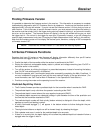
®
Receiver
5. During the tone, click the trigger again and continue to hold the receiver level and steady. You will
then hear 2 beeps followed by a long 6-second tone, indicating that the first calibration point is found.
6. During the 6-second tone, raise the receiver straight up, keeping it level and in the same plane above
the transmitter, as high as you comfortably can. Before the 6-second tone ends you must steady the
receiver and click the trigger.
7. Continue to hold the receiver in this position until you hear 3 beeps indicating that the second
calibration point was found and the calibration procedure is complete.
8. Reset the ultrasonic measurement to zero and check the depth reading while the receiver is sitting on
the ground directly above the transmitter. To verify a good calibration, check the depth at two
different elevations above ground using the ultrasonics, as described below under “Confirming Proper
Calibration.”
NOTE: If you hear 2 long beeps, there has been a calibration error, which can be caused by
an unstable or weak signal or a failed ultrasonic reading.
To calibrate (older receivers manufactured prior to 1995 that haven’t been updated):
1. Place the transmitter into the drill head housing and place on the ground.
2. Cover the transmitter with a flat surface (e.g., a clipboard, piece of cardboard, plywood, etc.) to pro-
vide an ultrasonic response surface.
3. With the trigger held in, position the receiver over the tool using the plus/minus (“+/–”) flip to verify that
the receiver is directly over the transmitter’s antenna. Be sure that the signal strength is less than
200 (top left window). If it is more than 200, raise the receiver slightly.
NOTE: Mark I Receivers without upgrades do not show 0-999 signal strength. You should
see a 7 in the top right window (gain stage 7) and a value of 200 or less in the top left
window when performing the 2-point calibration.
4. Follow the instructions given above for calibrating newer receivers beginning with step 4.
Confirming Proper Calibration
The ultrasonic function can be used to confirm proper calibration when the transmitter is below ground.
Check the depth measurement with the receiver held at one position (above the transmitter), then raise
the receiver to a new elevation, click the trigger to set the ultrasonics, and note the depth reading. If the
depth readings are the same (within 2 inches [5 cm]), then the calibration is good. If the depth readings
are not within 2 inches, then the depth/distance readings cannot be relied on and recalibration should be
performed.
DigiTrak
®
Mark III Operator’s Manual 15


















